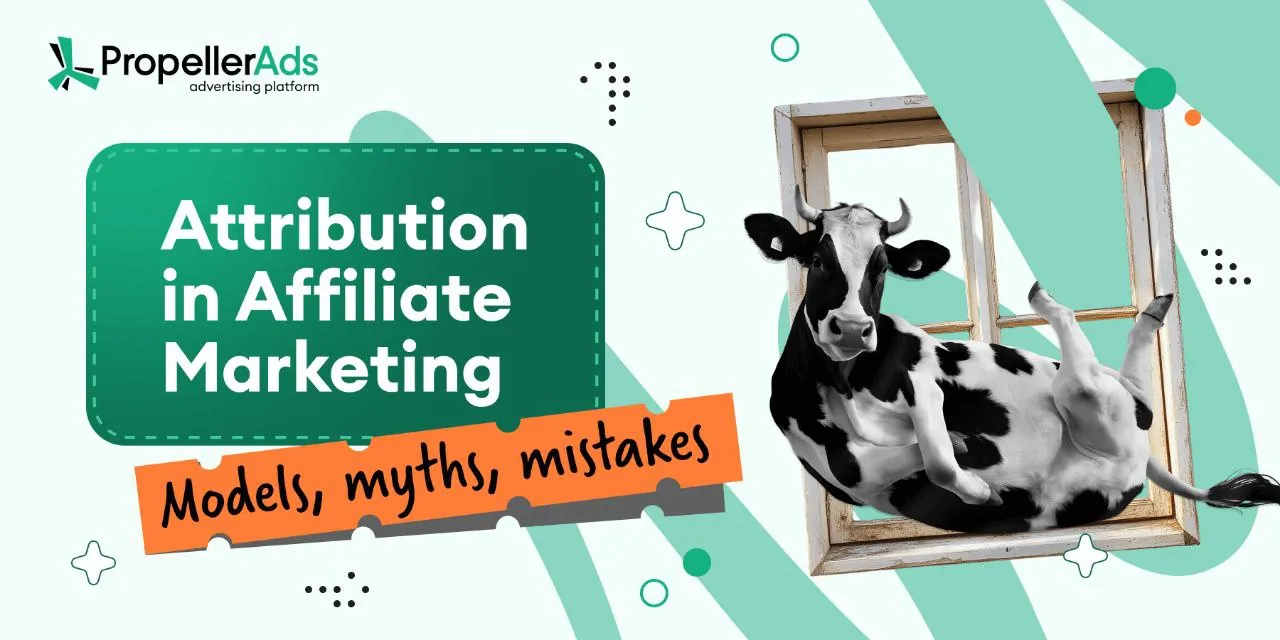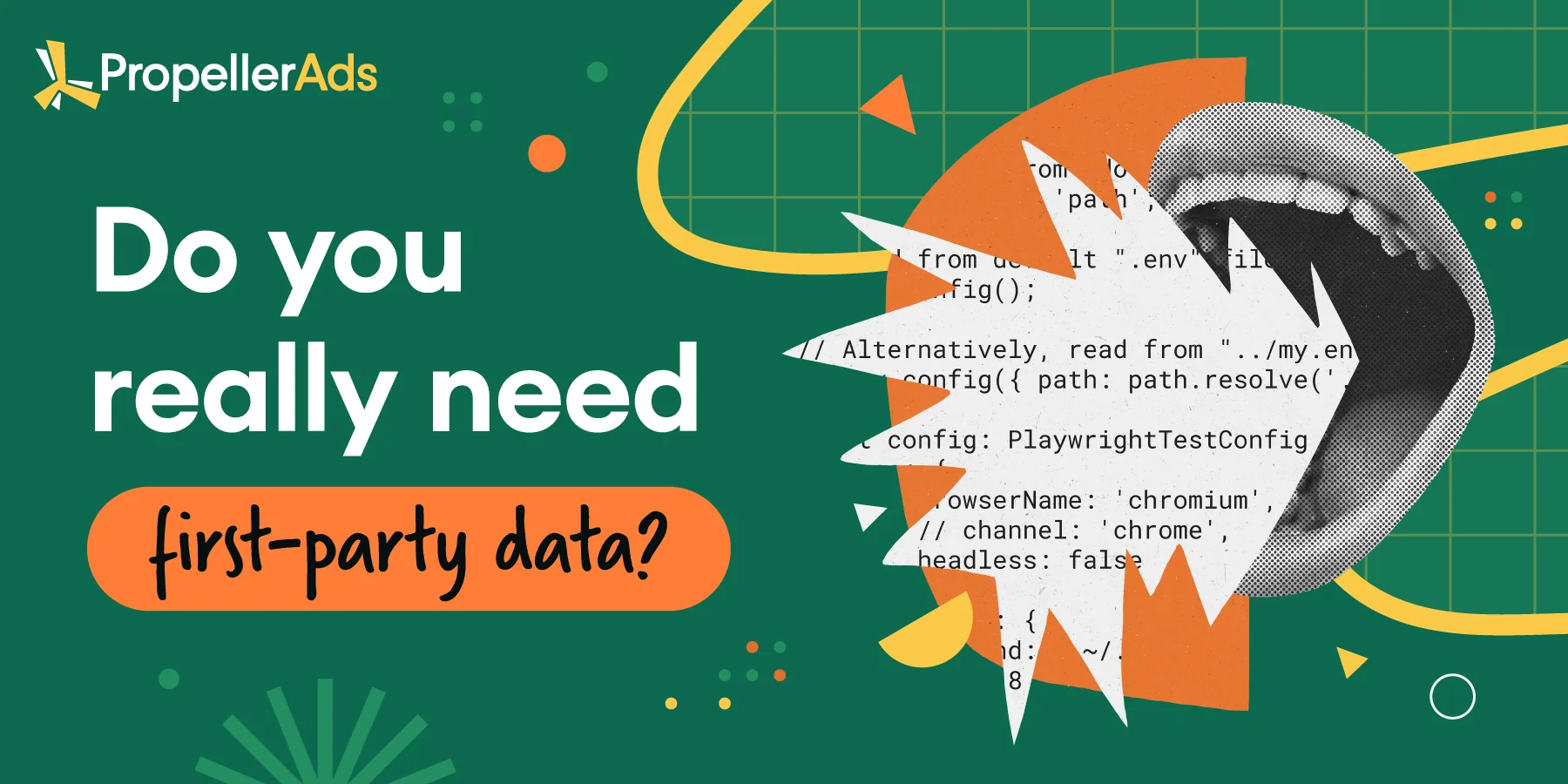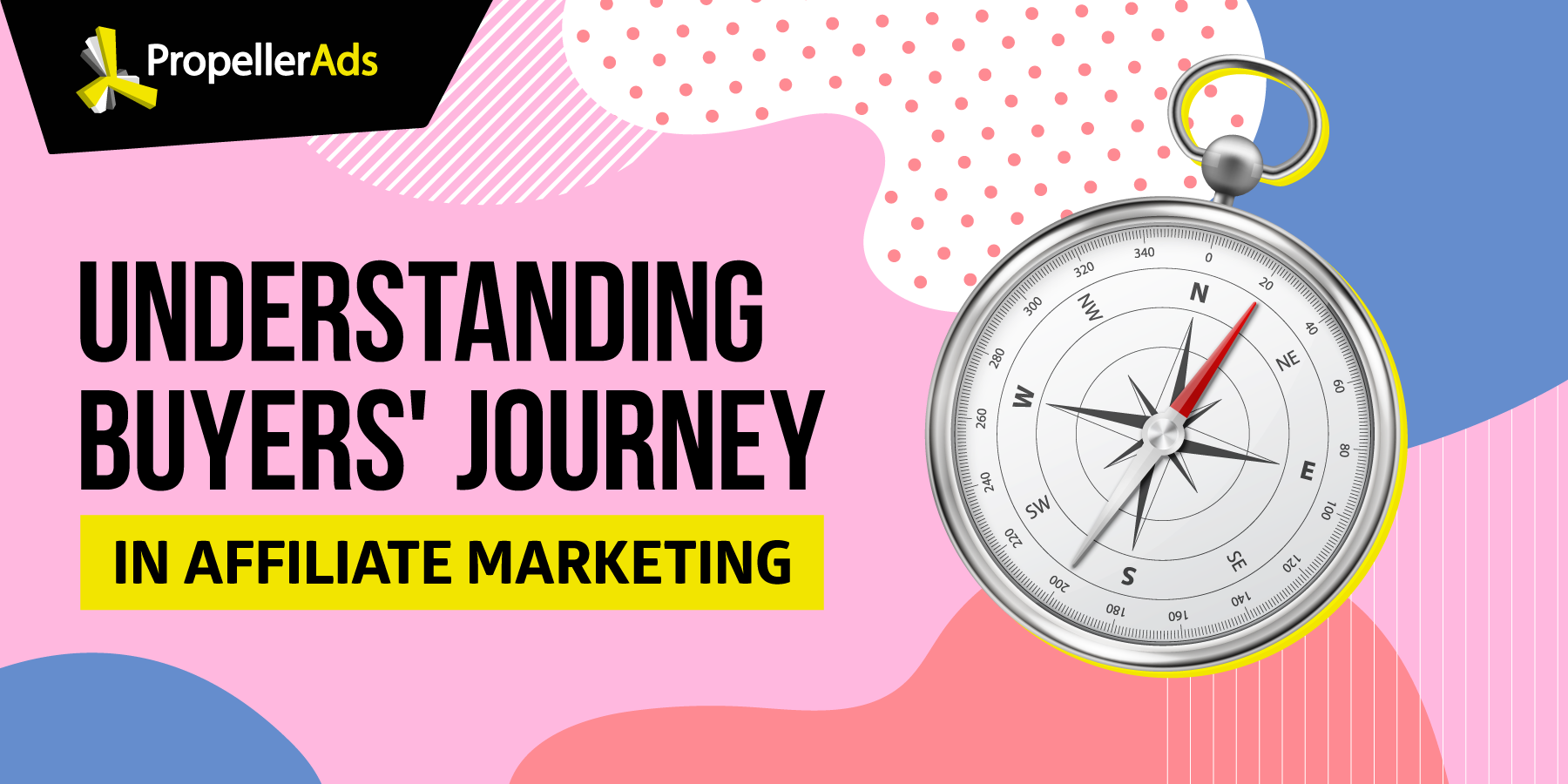Understanding Attribution in Affiliate Marketing (with Expert Voices)

Attribution in affiliate marketing is a whole web of decisions behind user actions and your commissions. In simple words, it’s about who gets credit for the desired click and how long we look back to define it. And if this feels like a bouquet toss at the wedding for you, then we are here to explain the rules of the game, so you always know who gets the flowers.
We’ll explore what attribution is (and why windows matter), how attribution ties to ROI, which models are used (and why last click still gets so much love), and the problems affiliates face.
We’ll also include real comments from our partner affiliate Ruslan, CEO of AffTrends, Alexandra Emelianova, PropellerAds Senior PPC Specialist, and Serge Abramov, PropellerAds Head of Media Buying, to bring in practical insights.
What is Attribution and Why Windows Matter
Attribution in affiliate marketing is the process of deciding which affiliate (or which touchpoint/marketing interaction) gets credit for a conversion – whether it’s a sale, a signup, a lead, etc. Since consumers often interact via multiple channels (social media, search, banner ads, newsletters) and go through a number of funnel stages, attribution is about drawing the line: who gets rewarded?
An important element of the process is an attribution window – the timeframe during which a given touchpoint can be credited for a conversion. Say, if your window is 7 days, then any click within that 7-day span prior to conversion may be eligible for credit, depending on the model. If the window is very short (like, 1 day), many earlier interactions will be ignored, and if it’s very long (30 days or more), even older influences will count.
Senior PPC Specialist Alexandra Emelianova notes:
“The choice of attribution window depends on the business model and the product being promoted. In CPA marketing it’s crucial to know what action the advertiser is paying for – registration, lead, or purchase. For classic lead generation, 7-14 days is usually enough since decisions are made quickly, while for services with longer sales cycles you might extend the window to 30 days.”
Why should you even care? Because the length of that window and which interactions you include or exclude dramatically affect which affiliate gets paid, how to judge performance, and ultimately how to allocate budget and set strategy right. If the window is too short, many affiliates who appear early in the marketing funnel might get nothing.
Attribution and ROI: How They Are Connected
When you measure ROI, you want to see how much revenue or value came in VS what you spent. But if the attribution system “gives all credit” to one affiliate, or only for the last interaction, understanding where the revenue really came from, which channels are strong, and which are weak, gets tricky.
Attribution doesn’t just affect ROI in theory – the payout model you work with makes a big difference, too. As PropellerAds Head of Media Buying, Serge Abramov, explains:
“With RevShare, there’s often no strict deadline for attribution. If a user deposits money with an iGaming platform even a year later, the affiliate can still receive a percentage, as long as the user was tied to them at the start. With CPA, things work differently – there’s usually a fixed action (a purchase, install, signup) and a defined attribution window, often 1, 7, or 30 days. In large eCommerce programs you sometimes see something in between. The key point is that attribution is about when the user gets attached to you – not about how long you’ll be paid after that.”
This perspective is important: in RevShare, ROI can keep growing long after the first conversion, because the affiliate continues to earn from the same user. In CPA, ROI depends heavily on whether the conversion happens inside that attribution window – miss it, and your traffic looks wasted.
Risk: since the advertiser (offer owner) sets up and controls the model, there is a trust issue. Affiliates may suspect the setup is tilted to minimize their commissions and maximize advertiser ROI. Opt for reliable ad platforms only.
So, in practice:
- A narrow window + last-click model tends to show “fast, bottom-of-funnel” conversions, which can inflate the ROI of channels well at pushing that final click, but undervalue those that build awareness or do early-stage work that actually led to this click.
- If attribution is misaligned (advertiser expecting longer window, affiliate assuming last click, tracking not set up properly), what looks like profit might be a loss (or vice versa).
As Serge also warned:
“Yes – when it turns out the advertiser counted you by a different model, especially a shorter one, your whole media buying strategy can collapse.”
Attribution Models and When They’re Used
In affiliate marketing reality, you’ll almost always see the last-click model, since most networks and advertisers stick to it because it’s clear, simple, and avoids disputes. The rest are more common in brand-side analytics than in actual affiliate payouts, but to keep you 100% informed, we will describe them, as well:
| Model | How it works | When it’s used |
| Last-click | The affiliate or channel that had the final interaction (click or sometimes view) before the conversion gets all (or almost all) credit. | Traditional for affiliate networks because it’s simple to track, clear for payouts, and has the lowest dispute friction. Works well for offers with short sales cycles, where it’s crucial to measure what “sealed the deal.” |
| First-click | Credit goes to the very first touch that engaged a user into the funnel. | Used when awareness or acquisition is the priority, especially when affiliates are doing content marketing, educating users, etc. Helps reward those who bring in new audiences. |
| Linear | Distributes credit equally across all touchpoints. | Good when a brand wants fairness across interactions, or wants to optimize all stages of the funnel. But can blur the impact, decreasing clarity about which funnel stages brought most value. |
| Time-decay | Credit is given to touchpoints closer to conversion and less or no to earlier ones. | Useful when recent interactions are more meaningful (for retargeting and warm leads), but gives nothing to previous touches. |
| Position-based or U-shaped | Often gives high credit to first and last touch, some weight (lower) to middle touches. | A middle-ground: reward awareness (first) and closing (last), but still give some small nod to the rest. Used when both ends of the funnel are important. |
| Hybrid | Uses actual data + machine learning + business logic to assign credit and combines multiple models. | Works for mature programs with good tracking, long sales cycles, or complex customer journeys (may include both online and offline interactions). Known as optimal to optimize ROI precisely, but also – very complicated. |
So, the model depends on what needs to be optimized: speed and simplicity (last-click), new user acquisition and brand awareness (first-click), fair distribution across the funnel (linear), stronger control over recency (time-decay), a balance between awareness and closing (position-based), or ultimate accuracy and optimization (data-driven).
Alexandra adds a PPC perspective:
“In Google Ads I prefer data-driven attribution because it distributes value more objectively across all touchpoints. It helps reveal which campaigns actually create demand rather than just capturing the final click. By contrast, in last-click, brand and remarketing campaigns almost always look like the heroes, but data-driven attribution shows the real contribution of discovery, video, or display campaigns.”
In the affiliate marketing world, you will most frequently work with the last-click model. As our Head of Media Buying told us, it’s a traditional one, “almost everyone does it like that.” And Ruslan, CEO of Afftrends, shared his thoughts:
“Probably many choose last-click because of simplicity – whoever brought the lead gets rewarded. But in reality, things are a bit different. A user might have seen an ad in one place (warm-up), and another web affiliate just ‘got him hooked,’ so to say – and a lot of traffic is underappreciated. So yes, it’s convenient, but not always fair.”
Alexandra agrees:
“Last-click is maximally convenient for fast lead generation because it’s simple and transparent: all results are tied to the ad clicked just before conversion. But the drawback is clear – it undervalues top-of-funnel channels like PR placements, YouTube, or bloggers that build interest but aren’t the final touchpoint.”
And to be honest, this is not the only problem affiliate marketers and media buyers have to face when it comes to attribution.
Problems with Attribution Models
Let’s dive deeper into the real issues connected with attribution (all enriched with Ruslan’s comments):
Could feel unfair in many cases
As Ruslan told us before, the last-click model can feel a bit unfair, but in truth, every attribution model can feel biased depending on your role in the funnel.
- First-click looks unfair to closers who do the heavy lifting at the end.
- Linear models can frustrate everyone by diluting impact across too many touches that are not equally valuable.
- Time-decay undervalues initiators, and position-based leaves out the “middle players” who nurture leads along the way.
- Position-based or U-shaped models assume the first and last touches are always the most important, which isn’t true for every funnel. In niches with longer decision-making (Finance, Travel, Health, or some types of eCommerce), the middle can matter just as much.
- And even hybrid, data-driven models, being the most fair and logical, may have drawbacks. Only the advertiser (offer owner) or the ad platform sees and controls the algorithm. Affiliates cannot check results with their own trackers and rarely know how weights are assigned, which touches are prioritized, or even what data sources were included.
Alexandra Emelianova notes that this unfairness is especially visible in PPC campaigns:
“In Google Ads, brand and remarketing campaigns almost always look like the key drivers in last-click, while YouTube, Discovery, or Display campaigns appear ineffective. But when you switch to data-driven attribution, it becomes clear that those top-funnel campaigns actually build the demand and prepare users to convert later.”
External voices also echo these points. Many affiliate marketers on forums like Afflift, BlackHatWorld, or Reddit complain that last-click “steals” their value, while networks defend it as “clear and fair.” Meanwhile, larger brands on LinkedIn often argue for hybrid or multi-touch attribution, but admit implementation is technically complex and not always affiliate-friendly.
As Serge Abramov adds, there are also rarer setups in the market, like retargeting attribution models. In these cases, affiliates or networks get rewarded for bringing back existing users – for example, if a user has already visited a site but later returns and converts through a retargeting campaign. While this model is not widespread, it does exist and shows how attribution can sometimes be tied to very specific strategies, like re-engagement rather than acquisition.
Too short a window
Most likely, a too short window can lead to lost earnings, because “if the attribution window is too short, all your traffic can end up wasted – no conversions credited, no payouts.”
With a window that’s too short, part of the user journey can get blurry, and affiliates may not get credited for the value they brought. Imagine a user who clicks your ad, browses, but waits a few days before taking action. If the attribution rule says that registration must happen within 24 hours, then missing that window means the user won’t be tied to you at all – even if they later deposit or buy something. In that case, your traffic really does go to waste.
But as Serge Abramov points out, it’s not always so black and white:
“If a user registers within the window, then they’re already tied to you. Even if they make a purchase much later, you’ll still get credit. Sometimes you see different rules: for example, registration within 1 day, but purchase allowed within 30 days. So it really depends on the advertiser’s setup.”
Alexandra Emelianova confirms this challenge from the PPC side:
“In Facebook Ads, users often see a campaign but convert later through Google search or by going directly to the site. In Meta’s reports, those conversions don’t appear, so the campaign looks like it didn’t work – even though it actually influenced the decision. Similarly, in Google Ads, campaigns like YouTube or Discovery may look unprofitable in last-click reporting, while in reality they nourished the funnel.”
This distinction is crucial: in some offers, the short window affects the first action (like a signup), while later monetization still counts. In others, both registration and purchase are bound to tight deadlines, which makes the affiliate’s job riskier.
More effort to adapt the strategy
As Ruslan puts it, “oftentimes you need to adjust your existing funnel depending on the attribution window. For example, if there is a too short attribution window, you can choose simpler offers, shorten the path, and reduce unnecessary steps.”
In day-to-day campaigns, this could mean that if an affiliate runs a multi-step funnel with a quiz or a content-rich pre-landing page, they might want to cut those extras and guide the user straight to the offer. The idea is to minimize delays so the user converts quickly and within the available window – before credit can slip away.
However, not everyone agrees this approach always works. PropellerAds Head of Media Buying Serge Abramov cautions that “it’s very debatable whether an unprepared user will convert faster just because you cut steps from the funnel.” His point highlights the trade-off: simplifying a funnel can increase speed, but it may also reduce the quality of the lead if users don’t get enough time or information to warm up.
On the contrary, when the attribution window is too long (14 or even 30 days), affiliates can play the long game. Here, they can afford to use quizzes, pre-landers, or content-driven funnels that capture emails, cookies, or push opt-ins. These touchpoints allow for further follow-ups: remarketing ads, email reminders, or push reminders. So if a user abandons the cart but comes back a week later – your initial click can still be credited. In this way, a longer window supports nurturing strategies where conversions don’t have to happen instantly.
Summary and Takeaways
As we wrap up, here are some key takeaways and suggestions:
- Clarify attribution definitions upfront with partners: what model, what window, and what counts (views, clicks, purchases?). If you don’t agree at the beginning, this can end up with disputes and lost commissions.
- The model ideally reflects the campaign goal. For example:
Awareness + a long funnel = use models that credit early touches.
Fast conversions + bottom-funnel offers = last-click may suffice. - Adjust strategy: depending on the attribution window/model, you might need to simplify funnels, shorten paths, and choose offers accordingly.
- Watch for discrepancies: device differences, cookie issues, advertiser vs affiliate dashboards often differ. It’s better to know what data each side uses, if possible.
Final Thoughts
Even though attribution may seem like a nerdy tracking talk (and maybe, it is), but it shapes who gets paid, which strategies get funding, and what channels get optimized (or cut off).
Thus, with alignment, transparency, and willingness to adjust, affiliates and advertisers both gain: affiliates get rewards more commensurate with their effort, advertisers get clearer visibility on where true value lies, and ROI measurement becomes less distorted.
And at PropellerAds, you’ll always find high-quality traffic from sources only as well as precise tracking that ensures your efforts are always rewarded. Join us and see how fair payouts can fuel your growth!
Join our Telegram for more insights and share your ideas with fellow-affiliates!






